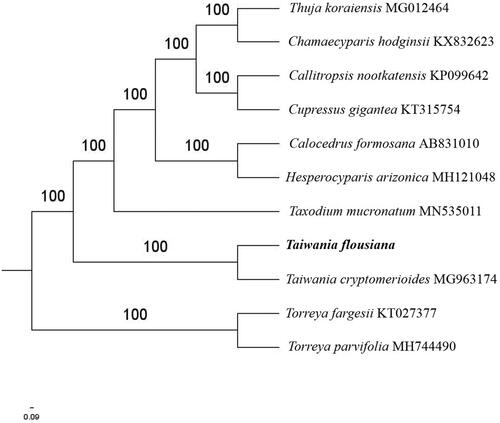Abstract
The first complete chloroplast genome (cpDNA) sequence of Taiwania flousiana was determined from Illumina HiSeq pair-end sequencing data in this study. The cpDNA is 132,565 bp in length, contains a large single copy region (LSC) of 72,930 bp and a small single copy region (SSC) of 59,477 bp, which were separated by a pair of inverted repeats (IR) regions of 79 bp. The genome contains 121 genes, including 83 protein-coding genes, 4 ribosomal RNA genes, and 34 transfer RNA genes. Further phylogenomic analysis showed that T. flousiana and Taiwania cryptomerioides clustered in a clade in Cupressaceae family.
Taiwania flousiana is the species of the family Cupressaceae. It is mainly distributed in China and northern Burma (Xiang et al. Citation2004). It is rare and precious tree species in the world and unique living fossil plants in China (Yin et al. Citation2018). T. flousiana is an excellent precious timber tree species, the wood can be used in building, making furniture and coffins, bridge and boat construction, and paper manufacture, it’s also an excellent garden greening tree species (Wei et al. Citation2018). Taiwania flousiana has great scientific value for the study of paleogeography, paleoclimate, and palaeoflora (Lian Citation2019). However, there has been no genomic studies on T. flousiana.
Herein, we reported and characterized the complete T. flousiana plastid genome. The GenBank accession number is MN897726. One T. flousiana individual (specimen number: 201903072) was collected from Kunming arboretum, Yunnan Academy of Forestry, Yunnan Province of China (25°14′20″ N, 102°75′17″ E). The specimen is stored at Yunnan Academy of Forestry Herbarium, Kunming, China and the accession number is WQH001. DNA was extracted from its fresh leaves using DNA Plantzol Reagent (Invitrogen, Carlsbad, CA, USA).
Paired-end reads were sequenced by using Illumina HiSeq system (Illumina, San Diego, CA). In total, about 23.8 million high-quality clean reads were generated with adaptors trimmed. Aligning, assembly, and annotation were conducted by CLC de novo assembler (CLC Bio, Aarhus, Denmark), BLAST, GeSeq (Tillich et al. Citation2017), and GENEIOUS v 11.0.5 (Biomatters Ltd, Auckland, New Zealand). To confirm the phylogenetic position of T. flousiana, other eight species of Cupressaceae family from NCBI were aligned using MAFFT v.7 (Katoh and Standley Citation2013). The Auto algorithm in the MAFFT alignment software was used to align the eleven complete genome sequences and the G-INS-i algorithm was used to align the partial complex sequences. The maximum likelihood (ML) bootstrap analysis was conducted using RAxML (Stamatakis Citation2006); bootstrap probability values were calculated from 1000 replicates. Torreya fargesii (KT027377) and Torreya parvifolia (MH744490) were served as the out-group.
The complete T. flousiana plastid genome is a circular DNA molecule with the length of 132,565 bp, contains a large single-copy region (LSC) of 72,930 bp and a small single-copy region (SSC) of 59,477 bp, which were separated by a pair of inverted repeats (IR) regions of 79 bp. The GC content of the LSC and SSC regions are 35.7 and 33.3%, respectively. The plastid genome contained 121 genes, including 83 protein-coding genes, 4 ribosomal RNA genes, and 34 transfer RNA genes. Phylogenetic analysis showed that T. flousiana and Taiwania cryptomerioides clustered in a unique clade in Cupressaceae family (). The determination of the complete plastid genome sequences provided new molecular data to illuminate the Cupressaceae family evolution.
Disclosure statement
No potential conflict of interest was reported by the author(s).
Additional information
Funding
References
- Katoh K, Standley DM. 2013. MAFFT multiple sequence alignment software version 7: improvements in performance and usability. Mol Biol Evol. 30(4):772–780.
- Lian YJ. 2019. A Preliminary report on the collection and conservation of Taiwania flousiana Germplasm Resources. J Fujian for Sci Tech. 42(2):55–58.
- Stamatakis A. 2006. RAxML-VI-HPC: maximum likelihood-based phylogenetic analyses with thousands of taxa and mixed models. Bioinformatics. 22(21):2688–2690.
- Tillich M, Lehwark P, Pellizzer T, Ulbricht-Jones ES, Fischer A, Bock R, Greiner S. 2017. GeSeq-versatile and accurate annotation of organelle genomes. Nucleic Acids Res. 45(W1):W6–W11.
- Wei JG, Zhou G, Liu FS, Yang ZW, Mo SZ, He B. 2018. Accumulation and distribution pattern of carbon in ecosystems of Taiwania flousiana and successive rotations of Cunninghamia lanceolata plantations. Subtrop Agric Res. 14(1):29–33.
- Xiang Y, Yang SP, Zhan ZJ, Yue JM. 2004. Terpenoids and phenols from Taiwania flousiana. Acta Bot Sin. 46(8):1002–1008.
- Yin RP, Lu DW, Zhang CH, Jiang Y, Yang DJ, Pu YQ. 2018. The biological characteristics of planted Taiwania flousiana. J West China for Sci. 47(3):50–55.

